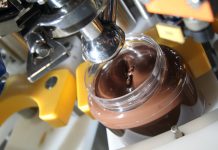Single or two-stage processes and ball milling. Refining systems have evolved so that chocolate paste reaches optimal palatability thanks to perfect particle size and even distribution.
When the cocoa pod, the fruit that grows on the cocoa tree (Theobroma cacao),is ripe it can contain up to 40 beans. After harvesting, fermentation, drying, and roasting, it’s time for refining, conching, tempering and finally moulding. All these processes are important in order to obtain good chocolate and the role of refining is not to be underestimated. The objective of this operation is to create a chocolate that produces the right sensation on the palate, in other words a chocolate that is neither gritty nor gummy, a result which can be obtained by reducing the size of the particles to no greater than 25 μm. Our taste buds in fact feel grainy particles in sizes over 20-25 μm. However, particle size should not be too small or else a higher quantity of cocoa butter is needed in the following steps in order to reduce the excessive gumminess of the mix. Good refining doesn’t just depend on the final size of the particles but also on how evenly they are distributed. Finally, the most efficient refining results in a paste containing a fat content which ranges from 25 to 27%.
Roller Refining Systems
Refining is accomplished by using a mill with two/three or five smooth rollers stacked one above the other. If the sugar that is used is in powdered form, the refining process starts directly with the five roller refiner. If, on the other hand, sugar crystals are used, with higher graininess, the size of the particles must be reduced in the two-three roller refiner before completing the process in a five roller machine. This is referred to as a two step process, with first a pre-refining and then the actual refining step. The objective of pre-refining is to reduce the particle size, especially that of the sugar, so that the particles measure from 400 to 1000 micron, in order to obtain an overall granularity between 80 and 120 micron. The grinding of the sugar particles also causes the other ingredients to absorb the fat. The chocolate paste will be more compact and ready for the following refining phase. Whether dealing with pre-refiners or refiners, the rollers, once made from granite but now in stainless steel, are spaced apart by devices that apply different levels of pressure on the individual rollers. The distance or light determine the level of grinding, while the work surface or refining table depends on the length of the roller itself, which currently ranges from 1 to 2.5 m with varying intensities. In a five roller refiner, the bottom roller is stacked slightly our of phase, acting as a feeder which causes the paste to move up into the second and subsequent rollers. These rollers rotate at a higher speed in order to capture the paste, causing it continue to move up and they exert a grinding force that is higher and higher at each roller level in order to reduce the particle size. One of the fundamental keys to success in the refining process is this varying speed between the rollers, as this is required to make the chocolate paste move upwards between the spaces between the rollers. Roller pressure is hydraulically controlled. The cold water that circulates inside each roller serves to lower the heat that develops due to friction from the roller movement and contact with the paste. With this method, the temperature of the chocolate paste is reduced to around 25°C at detachment. Roller temperature is regulated to decrease or increase the adhesion of the chocolate paste to the roller. For quick moving products, the roller temperature will be reduced and vice versa in the opposite case. The product passes from one roller to the next and is scraped off the top roller at each conching step. The chocolate paste being processed in the refining mills must be homogeneous so as to render a uniform production batch. The operation is optimized when the amount of fat in the product ranges between 22 and 30%. Modern refiners are able to work 1,200 kilograms per hour of product at a refining level of under 18-20 micron. Lower volume production runs are required for greater fineness in the final product and are accomplished with smaller roller slits and vice versa. The rollers can bend in the centre during the rotation and this deformation can have a negative effect on the refining since we are dealing with a particle size that is measured in microns. To avoid this problem, which puts the whole refining process at risk, the rollers are designed to be curved outwards in the middle and the curve must be well-calibrated. Refining systems are regulated based on different parameters like roller temperature, number of rotations of the lowest roller, pressure between the rollers, and the intensity of the power line that feeds the motors. Regarding the efficiency of the refining process, it has been demonstrated that the two step process is better than the single step one. Pre-refining produces a chocolate mass with an optimal granularity at the initiation of the real refining step and results in higher productivity (10-20%) and a more homogenous product in the end. It’s possible to regulate the rheological characteristics of the paste to be refined and to reduce the amount of fat in the chocolate paste. There is an improvement in the aromatic qualities of the mass of processed chocolate since the use of sugar in powdered form can cause an off-flavour, especially a metallic taste derived from the grinding of the sugar itself. The single step process, in addition, requires higher energy costs and more mixing time. The models of refiners on the market today are built to provide greater precision and reliability as well as higher production capacity, accessibility for inspection and cleaning, with significant lower maintenance efforts due to improved positioning of the refining rollers. Software controls are also available to ensure that the machine doesn’t run without product. It’s possible to manage the work cycle both automatically with PLCs or manually.
Ball mill refiner lines
Alongside roller refiners are ball mills, which work well with recipes calling for 30% fat content. The fineness obtained in products processed with this method (creams for spreading, filling and icing, creams for ice cream, chocolate or compounds) varies according to the refining time and can reach a particle size of 20-22 micron. These refiners are economical and versatile, constructed in stainless steel and highly resistant, with production capacities from 25 to 500 kilograms. These machines are equipped with a pre-mixing tank, where the various ingredients are introduced. There is software that can follow more than one recipe, regulating the different parameters like time, refining temperature as well as recipe ingredient amounts. The actual refining takes place with a stirring shaft and arms and tempered steel balls that rotate in the double-walled grinding tank. The various elements to be refined move in the same direction but at different speeds in a way that the speed of the balls at the ends of the arms is elevated but almost non-existent at the edges of the tank. In this way, friction is reduced between the balls and the chamber wall and the wear and tear is decreased. Cooling, in this case, does not take place with a water process. Ball mill refiners must work in batch or continuous mode. Both the stirring shaft and arms can be hollow in order to inject a controlled input of oxygen/air and nitrogen during refining. Filtered and sterilized air/oxygen functions to enhance the oxygenation, allowing the product to have a better quality than that obtained with a traditional roller refining with a conching effect. The influx of nitrogen, on the other hand, creates an inert atmosphere that prevents the oxygenation of the chocolate paste. In both cases external humidity and other unwanted aromas in the ambient air can be controlled.







Sir
If sugar crystal size increase as raw material like 3~5mm then pre refiner roller gap increase/decrease?
Comments are closed.